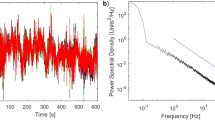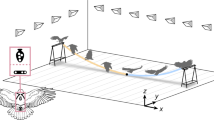Summary
-
1.
An 8 part 9 m long wind tunnel, built of wooden frames and chipboards supported by an iron tube base, specially suited for bird flight investigation, is described (Fig. 1, 2). The working section measures 1×1×1.4 m and consists of smoothly fitting interchangeable walls of glass, wood or metal. Maximum velocity is 24 m s−1 (86 km h−1). In the working section, velocity distribution is constant within 3% (Fig. 2c). Turbulence factors of 1.25 (15 m s−1) to 1.4 (24 m s−1) were measured.
-
2.
Pigeons were kept in dovecots in the wind tunnel room to accustom them to tunnel noise. A 5 phase training program used to train pigeons to fly in the wind tunnel is described in detail.
-
3.
Seven different pigeon races, including a newly bred hybrid, were tested. Homing pigeons were not fast enough for steering manoeuvers, hard to train and had varying flight styles. Nicolajew and Hannover pigeons interrupted their flight by pronounced gliding phases. Vienna and Serbian pigeons flew too nervously. English Tipplers flew permanently, but ‘swayed’ occasionally. Russian Griwunis flew calmly and steadily in flapping flight, sometimes interrupted by gliding periods. A hybrid from Tippler and Griwuni proved to be an ideal wind tunnel flier (Fig. 3), being easily trained and performing long, steady, powerful flights. Results are presented in a comparative manner with training diagrams (Fig. 4), flight time training relation (Fig. 5), flight ability data collection (Table 1) and mass loss data collection (Table 2). It is shown that Tipplers, Griwunis and especially the Grippler hybrids are suitable for wind tunnel experiments.
Similar content being viewed by others
References
Aulie A (1971) Body temperatures in Pigeons and Budgerigars during sustained flight. Comp Biochem Physiol 39A:173–176
Baudinette RV, Loveridge JF, Mills CP, Schmidt-Nielsen K, Wilson KJ (1976) Heat loss from feet of Herring Gulls at rest and during flight. Am J Physiol 230:920–928
Bernstein MH, Thomas SP, Schmidt-Nielsen K (1973) Power input during flight of the fish crow,Corvus ossifragus. J Exp Biol 58:401–410
Biesel W, Nachtigall W (1987) Pigeon flight in a wind tunnel. IV. Thermoregulation and water homeostasis. J Comp Physiol B 157:117–128
Bilo D (1970) Zur Methodik der kinematischen und aerody namischen Analyse des Kleinvogelfluges. Verh Dtsch Zool Ges Köln: 136–141
Bilo D (1971) Flugbiophysik von Kleinvögeln. I. Kinematik und Aerodynamik des Flügelabschlages beim Haussperling (Passer domesticus L.) Z Vergl Physiol 71:382–454
Butler PJ, West NH, Jones DR (1977) Respiratory and cardiovascular responses of the pigeon to sustained level flight in a wind tunnel. J Exp Biol 71:7–26
Hirth D, Biesel W, Nachtigall W (1987) Pigeon flight in a wind tunnel. III. Regulation of the body temperature. J Comp Physiol B 157:111–116
Nachtigall W, Rothe J (1978) Eine Methode, Tauben für den freien Flug im Windkanal zu trainieren. Naturwissenschaften 65:266
Nachtigall W (1984) Vogelflugforschung in Deutschland. J Orn 125:157–187
Pennycuick CJ (1968) A wind tunnel study of gliding flight in the pigeonColumba livia. J Exp Biol 49:502–526
Rothe HJ (1982) Physiologische Untersuchungen an fliegenden Tauben (Columba livia) im Windkanal. Dissertation, Universität des Saarlandes
Rothe HJ, Biesel W, Nachtigall W (1987) Pigeon flight in a wind tunnel. II. Gas exchange and power requirement. J Comp Physiol B 157:99–109
Torre-Bueno JR (1976) Temperature regulation and heat dissipation during flight in birds. J Exp Biol 65:471–482
Tucker VA (1966) Oxygen consumption of a flying bird. Science 154:150–151
Tucker VA (1968) Respiratory exchange and evaporative water loss in the flying Budgerigar. J Exp Biol 48:67–87
Wille (1963) Beiträge zur Phänomenologie der Freistrahlen. Z Flugwiss 11:222–232
Author information
Authors and Affiliations
Additional information
This series of four articles: “The pigeon flight in a wind tunnel” is dedicated to Prof. H. Autrum on the occasion of his 80th birthday
Rights and permissions
About this article
Cite this article
Rothe, H.J., Nachtigall, W. Pigeon flight in a wind tunnel. J Comp Physiol B 157, 91–98 (1987). https://doi.org/10.1007/BF00702733
Accepted:
Issue Date:
DOI: https://doi.org/10.1007/BF00702733




